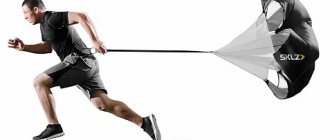Jogging is also called “shuffling”, “relaxed” running or “jogging” from the English. “jog” - “jog, push.” If you look at Ozhegov’s dictionary, the word “coward” means slow, calm running. To summarize, we conclude that jogging is jogging at a leisurely pace, with a relaxed step. The average speed of a runner is no more than 8 km/h, which makes it easy to run long races.
What is jogging
Jogging or jogging formally differs from regular running in pace: 7 minutes per kilometer and slower is more likely to be jogging than running. True, there is a difference in other moments: during jogging, the so-called “flight phase,” that is, the moment when both legs do not touch the ground, is minimal, but in running it increases with increasing speed.
During jogging, there is barely any forward lean angle, and it is more common to land on the heel rather than the front of the foot (although from a biomechanical point of view this is not correct). But, perhaps, the speed of jogging also depends on the physical form of a particular person and is individual for everyone. The main criterion is the sensations during this type of physical activity: when jogging, the load is low, there is no severe shortness of breath and tension in the muscles. This is the pace at which it seems that you can move forever.
50 developmental exercises for training at home
Preparing to run
Jogging does not eliminate the need to warm up. It will allow the muscles and ligaments to warm up, preventing injuries and discomfort. To prepare for a run, it is recommended to perform some general strengthening exercises, combining them with different types of walking:
- On toes and heels.
- Simple and fast.
- With turns.
- On the outer and inner surfaces of the feet.
- With high hip lift.
- With circular movements of the body.
- With different positions of the hands (forward, behind the head, on the belt, up, to the side, and so on).
Various bends, turns, and swings are also useful in warming up. All this allows you to prepare the body and prevent a number of unpleasant consequences.
Who is jogging suitable for?
It is quite correct to say that jogging is suitable for everyone: it is useful for both beginners and experienced athletes. However, if for “experienced” runners training at a very low pace will be purely restorative in nature, for beginners it can become quite a heavy load. At the same time, you should start your journey into the world of running with jogging - after all, it is less dangerous than running, and it will be easier for a new athlete to cope with jogging than with running.
Thus, the main category of people who are suitable for jogging are beginner runners. True, jogging is no less useful for people who are at increased risk of injury: overweight people, older people or athletes recovering from injuries.
Is it possible to run with excess weight and where to start?
Benefits of jogging
Jogging is a type of cycling aerobic exercise. This means that the body produces energy by oxidizing fats or carbohydrates.
Such loads develop the cardiovascular system well: the heart muscle is trained and the vascular network improves in order to better deliver blood (and with it oxygen) to the muscles. As your training increases, shortness of breath disappears, and many everyday tasks become easier to do. The musculoskeletal system is strengthened: muscles and joints gradually develop; ligaments and tendons also adapt to the load.
Finally, jogging promotes additional calorie expenditure and, as a result, weight loss. Moreover, at this level of load, energy supply occurs mainly from fat.
The benefits of running: how running affects human health
Contraindications to classes
There are a number of diseases for which jogging is contraindicated.
Among them:
- Myopia, glaucoma. Jogging can cause retinal detachment.
- Any chronic diseases during the period of exacerbation. Here the advisability of jogging should be discussed with your doctor. Excessively active training can lead to a deterioration in your general condition.
- Colds. You should not run with a high body temperature, a sore throat or a stuffy nose. You should wait until you feel better, and only then resume training.
- Joint diseases - arthritis, arthrosis, osteochondrosis, intervertebral hernia. Even light running puts a lot of stress on your back and knees, which worsens the condition of your joints.
- Diseases of the respiratory system. Jogging requires active work of the lungs and can provoke an exacerbation of bronchial asthma or cause pulmonary failure.
- Diseases of the heart and blood vessels. Cardio training, which includes running, puts a high load on the heart muscle. A healthy person who regularly plays sports trains her endurance. The heart muscle of a sick person may not be able to withstand the proposed loads.
It is not recommended for older people to start running. At 60 years old, joints, ligaments, and muscles find it difficult to adapt to physical activity. Not only should you avoid running, but older people should also avoid high-intensity aerobic exercise. A replacement for jogging will be Nordic walking or yoga.
How to jog correctly
Jogging differs from regular running in that the pace is low and the flight phase is minimal. Due to the low speed, often when jogging people begin to move their hips forward and land on their heels: the lower the forward lean of the body, the more difficult it is to run with the correct technique.
However, the least damaging running technique does not change depending on the pace. Landing when jogging should be on the front surface of the foot, under the pelvis, without moving the hip forward. It is also worth remembering to respect the slope of the body in the direction of movement. But it is important to understand that bending the lower back or tilting the head forward shifts the center of gravity, so the tilt should be done with the whole body.
Breathing and heart rate while jogging
Jogging does not involve strong accelerations, the body works in an aerobic mode, and this load should be felt in this way: there is practically no shortness of breath, you can calmly carry on a conversation while jogging. If you start to feel out of breath and it seems that there is not enough oxygen, you are running too fast and you need to slow down the pace or even take a step.
You should breathe through your mouth and nose, without specifically concentrating on inhalation - after all, this is a natural process that does not require awareness.
Jogging for weight loss
Since at a moderate level of exercise the body uses mainly fats for energy, jogging is an excellent way to lose weight. We described on our website how and how much you need to run to lose weight.
It is important to understand that weight loss occurs solely due to the negative delta of calories: that is, when you consume less energy than you expend. The average energy consumption of jogging is 100 kcal for 10 minutes. Therefore, by adding jogging to your daily routine, without increasing your food intake, you will lose weight. However, you should not expect immediate results. If you increase your caloric intake while jogging, weight loss will be unlikely.
How to start jogging
The main principle of starting any sport, and jogging is no exception, is the smoothness of the load. At first, the load should remain within comfortable limits. You can start with 20 minutes and gradually increase the training time, doing them every other day. If it is difficult to jog for all 20 minutes, then you can do intervals of jogging and walking, gradually lengthening the former and shortening the latter.
If running is still very difficult for you, try Nordic walking with poles at the initial stage.
How much and when to run
It is preferable to run for 40 to 60 minutes 2-3 times a week. During the first 40 minutes, the body extracts energy from glycogen, an easily digestible sugar stored in the liver, to fuel muscles. Only when glycogen is used up does the body begin to draw energy from fat reserves.
This happens 10-20 minutes after a 40-minute run. After an hour, it becomes difficult for the body to maintain its energy needs, and it begins to obtain energy from muscle protein, which is best avoided. If you want to preserve muscle, long runs are not the best option.
American scientists conducted a study and found that level 1 of physical fitness (running, cycling, swimming, aerobics, etc.) is best done from 7 a.m. to 5 p.m. until 1 p.m. Athletes who do cardio at night have a 65% higher metabolic rate.
Nevertheless, experts advise trying to run at different times and choosing the best option. If you're not training for a race, you can run at your current pace for fun.
To avoid insomnia, run 3-4 hours before bed. Don't run on an empty stomach - eat at least one banana. Eat a lean protein with fiber 1-2 hours after your workout.
Training plan for beginners
Week 1
- Monday: 5 minutes of intense walking, then alternating a minute of jogging and a minute of walking (10 repetitions).
- Wednesday: 5 minutes of vigorous walking, 2 minutes of jogging, 2 minutes of walking (5 reps).
- Friday: 5 minutes of intense walking, 2 minutes of jogging, 1 minute of walking (7 reps).
Week 2
- Monday: 5 minutes of intense walking, 3 minutes of jogging, 2 minutes of walking (5 reps).
- Wednesday: 5 minutes of vigorous walking, 4 minutes of jogging, 2 minutes of walking (4 repetitions).
- Friday: 5 minutes of intense walking, 5 minutes of jogging, 2 minutes of walking (4 repetitions).
Week 3
- Monday: 5 minutes of vigorous walking, 7 minutes of jogging, 3 minutes of walking (3 repetitions).
- Wednesday: 5 minutes of vigorous walking, 10 minutes of jogging, 3 minutes of walking (2 reps).
- Friday: 5 minutes of vigorous walking, 10 minutes of jogging, 3 minutes of walking (3 repetitions).
But, of course, we must not forget that a coach can draw up a plan that suits you individually. And the above diagram is just general advice for starting training.
You may be interested in: Health running: benefits and contraindications
6-Week Training Plan for Your First 10K Race
Cautions
With all the advantages of jogging, one should not forget that moderation is needed in everything. What heals us can just as easily cripple us if we get carried away and forget about moderation. Any medicine has contraindications. What benefits our health can be harmful – even something that seems harmless at first glance.
Jogging can cause considerable damage to your health, and it is better to know about the risks in advance.
For joint problems
I said earlier that the load on the joints during such running is small. But even this is enough to aggravate health problems, if any. Foot kicks, which are constantly performed during movement, have a traumatic effect on the joints of the legs, pelvic organs and spine.
If you have joint diseases, it is better not to take risks, because stress on them can cause inflammation with complications. The risk increases significantly if you are overweight. So be careful and don't overdo it. For joint problems, Nordic walking with poles would be preferable.
Diseased heart
It is not recommended to jog if you have heart problems. Physical activity is good for him, but with reservations. You need to be very careful and choose the right time. Running in the morning or evening can be perceived by the body as a stressful situation.
Because in the morning the body is just emerging from sleep and is not quite ready for sports, and in the evening it is already tired. Instead of jogging, he needs rest. Abrupt transitions are not good for the heart.
As a result, tachycardia or other types of arrhythmia may occur. Instead of improving health, a person risks having a heart attack.
Without fanaticism
There is no need to force yourself to run in any weather. When it's hot, you risk getting heatstroke or sunstroke. During rain, on the contrary, there is a danger of catching a cold from hypothermia. This will not benefit you and will not help improve your health.
Under no circumstances should you be overtired. There is a difference between feeling pleasantly tired after a workout and feeling exhausted, where you just want to lie down and not get up. If you are not confident in your abilities, you should not test your strength and run long distances by force.
For the elderly
In adulthood, even healthy people have their risks. Joints and ligaments lose elasticity, so there is no need to take on excess load. An average load, on the contrary, will not only not harm, but will improve their condition. The duration of jogging should not exceed half an hour. Although, if you have been playing sports regularly before, you can run longer.
Interesting video: regular and running compared to jogging











